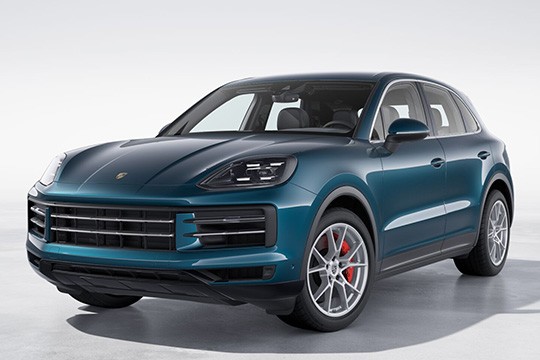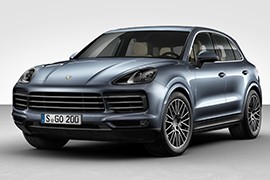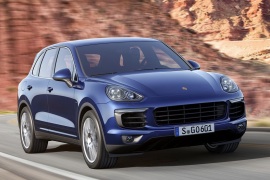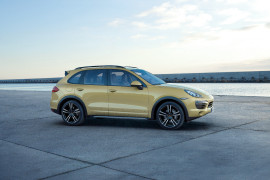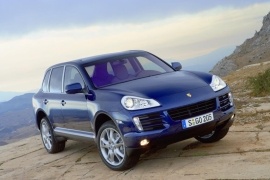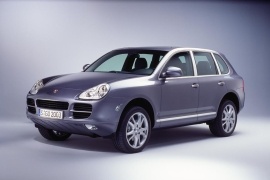PORSCHE Cayenne S Models/Series Timeline, Specifications & Photos
First production year: 2002
Engines: Gasoline, Hybrid gasoline
Body style: SUV (Sports Utility Vehicle)
Porsche refreshed the third generation of its flagship SUV, the Cayenne, in 2013, five years after the model's introduction at the Frankfurt International Motor Show.
The German automaker introduced the first generation of the Cayenne in 2002, and it instantly polarized the market. While the brand's hard-core fans were enraged, the company enjoyed huge sales. Soon, it became the best-selling Porsche vehicle. Fast forward more than two decades, and the third's generation facelift appeared on the market. But it wasn't just a slight update, especially for the base version known as the Cayenne S.
One of the most significant upgrades seen on the 2023 model was at the front fascia that sported standard Matrix LED headlights, which were previously offered as an option. In addition, the automaker offered an HD Matrix LED version for those. From its profile, the standard wheels grew in size from 19" to 20 inches. Finally, at the back, the automaker installed redesigned taillights. A distinctive feature of the vehicle compared to higher-powered Cayenne models was noticed under the bumper, where the carmaker installed rectangular chromed tips for the exhaust system.
Inside, the most significant upgrade was on the dashboard, which sported a completely digital instrument panel complemented by a touchscreen for the infotainment system atop the center stack. Furthermore, the side passenger could access music and other info on a third screen with touch capabilities mounted in front of them. Like its predecessors, the 2023 Cayenne S featured a luxurious interior with bolstered front seats and a split-folding bench seat in the back.
But the most crucial upgrade for the Cayenne S was under the hood. Porsche ditched the formerly used 2.9-liter twin-turbocharged V6 and installed a larger turbocharged 4.0-liter V8 that produced 34 more PS (33.5 hp). At the same time, torque was raised by 50 Nm (37 lb-ft) for a total of 600 Nm (443 lb-ft). Thus, the 0 to 62 mph (0-100 kph) time was reduced by 0.2 seconds.
The third generation of the Porsche Cayenne S was unveiled in August 2017 and launched in front of the public at the Frankfurt Motor Show in the same year.
The third generation of the Cayenne S was built on an entirely new platform, shared with the Bentley Bentayga and Lamborghini Urus. It was fitted with important technical upgrades, such as the rear-axle steering system, which allowed a better cornering speed and a better maneuverability in the parking lot.
At the front, the Cayenne S featured a continuous grille design, interrupted by three vertical slats. The turn-signals from the door-mirrors featured a dynamic light move due to the LED technology. On the side, the dynamic look was enhanced by the raked D-pillars and the roof-spoiler. In the back, two, wide, and four round exhausts were placed under the apron.
Inside, the Cayenne featured the new 12.3” Full-HD touch-screen from the Porsche Communication Management infotainment system. For the instrument cluster, only the tachometer remained analog and it was flanked by two 7” displays, needed for other relevant driving data. Due to the longer wheelbase, the rear passengers got more legroom than before, despite the thicker front seats.
For the drivetrain, the Cayenne S was fitted with a twin-turbo 3.0-liter V6 engine. It offered 20 hp more than its predecessor, reaching 440 hp. It was paired to a standard 8-speed automatic gearbox. The PTM (Porsche Traction Management) all-wheel-drive system was improved. Along with the pneumatic suspension, it offered a better road-holding and off-road abilities, despite not being fitted with a low-range transfer case anymore.
The facelifted version of the Porsche Cayenne was introduced in 2014 and it received a restyled design, new features, and, most important, upgraded engines, including for the S-version.
When it was introduced in 2002, the Cayenne S featured a 4.5-liter V8, which was a bridge between the standard V6 and the mighty Turbo. It was the middle ground. For the second generation's facelift, the Cayenne S was downsized, but better in any way.
The exterior of the 2014 Cayenne was enhanced with a sharper design and clear lines. The front fenders, the grille, and the headlights were entirely new. The grille was still divided into three main areas, with the biggest one kept for the engine. The underbody aluminum shield was replaced by a black plastic one. In the back, the roof-spoiler became a standard fit for the entire range.
Inside, the connection with the 911 range was more obvious due to the five-dials instrument cluster and the centrally-mounted tachometer. The new, tall and slim, air-vents were inspired by the Panamera sedan, but on the center console, the buttons from the PTM system were an updated version of those found in the first generation Cayenne.
Under the hood, the 2014 Cayenne offered a twin-turbo 3.6-liter engine. The displacement resembled the flat-six engines from the 911 range, but in a mid-size SUV, the V6 was a better choice. It was 20 hp more powerful than the non-facelifted Cayenne S. It was paired as standard to an 8-speed automatic gearbox. In the end, it obtained a better fuel-efficiency and it was quicker than its V8 predecessor by almost half a second in a 0-100 kph (0-62 mph) run.
The second generation of the Porsche Cayenne was launched at the 2010 Geneva Motor Show. It was a big improvement over its predecessor and featured an evolved design.
The first generation of the Cayenne brought as many fans as enemies to the German Porsche brand, but the fact was that it became the most sold vehicle from the brand's stable. Not only that the SUV trend was good for business, but it also offered true performances and comfort. It was the absolute Porsche for the entire family.
The second generation came with a lighter bodywork and new styling for the front, that resembled the Panamera. The hood was similar to the 4-door Porsche sedan as well. The big debate about the car was in the rear, where the taillights were somehow similar in the design concept with those from a Hyundai SantaFe.
Inside, the Panamera inspiration was obvious. A new steering wheel, instrument cluster, and buttons layout on the center console was installed. The center stack was redesigned as well and the vents were taller than the VW-like air-vents from its predecessor. The sunroof was standard for the S version.
For the engine, the Cayenne S featured a 4.8-liter V8 unit 100 hp stronger than the base, 3.6-liter version taken from the VW lineup, and 100 hp less than the 500 hp Cayenne Turbo. For the transmission, the 2010 Cayenne lost the low-range transfer case. The standard transmission was an 8-speed Tiptronic gearbox. All-wheel drive was installed standard as well.
Following the success recorded by its first SUV, Porsche decided to continue the saga and, in 2007, it introduced a facelift for the Cayenne.
After the first shock passed and the market understood that a Porsche SUV might be one of the best ideas to save the famous German sports-car brand, the critics started to lower their voices and customers started to order more. It was the perfect Porsche for a family, an excellent SUV, and an awarded off-road vehicle.
For the 2007 facelift, the German car-manufacturer listened to its customers and got rid of the Porsche 996-inspired headlights. The new ones featured a clear lens over the lamps and they were re-shaped. A new, vertical, daytime running light appeared on the outer side of the side-scoops and the center grille was smaller. The Cayenne S started to have its personality with the 17” light-alloy wheels fitted as standard. In the back, the redesigned taillights included a new, upper, spot for the reversing lamp. The Cayenne S featured a pair of exhausts placed on the outer sides of the rear apron.
The interior was almost unchanged when compared with its non-facelifted version. It featured the same seats and standard audio system. It received new colors for the leather seats. The Cayenne was the only version available with a 6-speed manual.
The technical department worked hard to update the car to the newest standards. The 3.2-liter V6 unit received a direct-injection system and the VarioCam (variable camshaft timing). It was mated as standard to a 6-speed manual. A low-range transfer box was available as well.
When launched in 2002, the Cayenne attracted as much hate as positive reviews from around the world. It was the first Porsche SUV and it could host five adults without any problems.
It was inconceivable for a Porsche fan to accept an SUV from the famous sports-car manufacturer. But the car was needed. The German brand needed a car to sell in volumes and save them from a foreseeable financial collapse. Despite all the odds, the Cayenne was well received by the market.
The exterior look was inspired by the 911, with headlights that resembled those installed on the 911 - 996 version. The tall greenhouse, for a Porsche, was designed according to the car's destination: as a family sports SUV. The Cayenne S was designed to be a sportier version for the base, 3.2-liter Cayenne. In the back, a dual exhaust system was installed and an aluminum shield was seen under the bumper.
Inside, the gear-selector was carried-over from 911. The instrument cluster and the keyhole were inspired by the famous German sports-car as well. A tall center console separated the front passengers. The power-adjustable leather front seats were accompanied by the rear leather bench, which featured a split-backseat to extend the trunk space. The Cayenne S featured a CD-radio with 12 speakers. A Porsche Communication Management (PCM) infotainment unit with navigation and a backup camera was available.
Under the hood, the Cayenne S featured a 4.5-liter V8 with a dry-sump lubrication system, which was an unusual technical solution for an SUV. It was paired to a 6-speed manual. A 6-speed automatic was on the options list.
